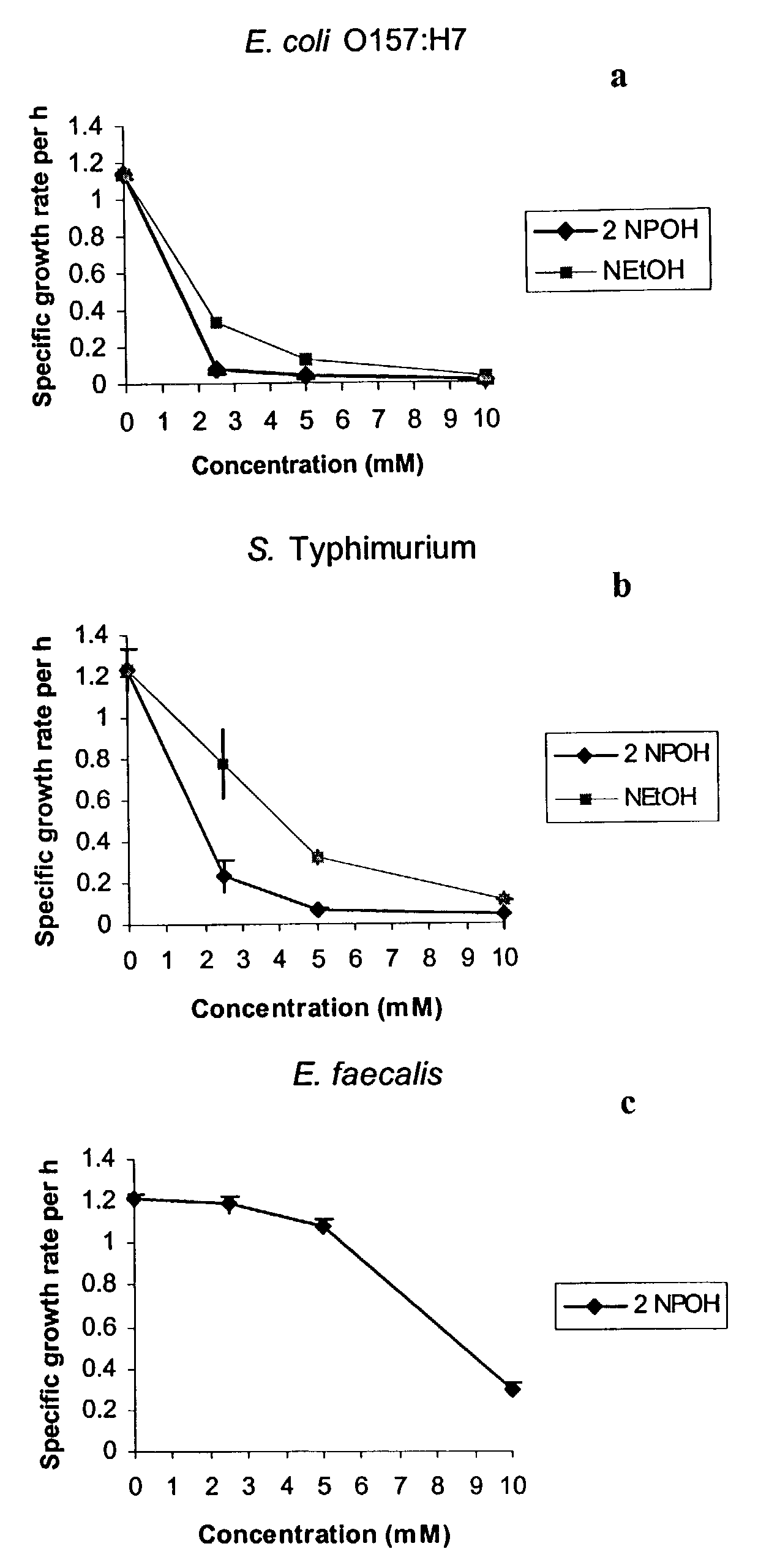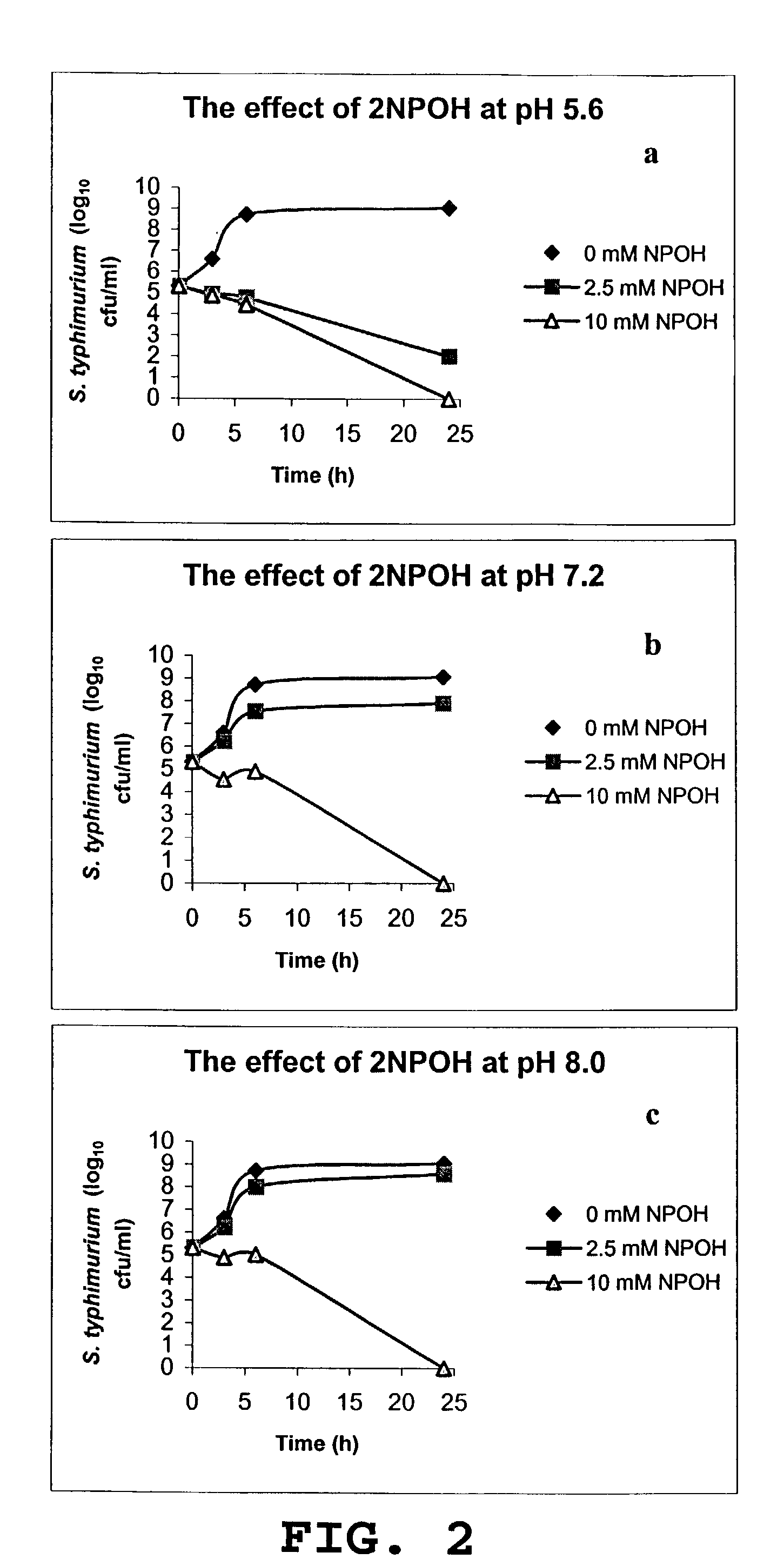Use of 2-nitropropanol, 2-nitroethane, and 2-nitroethanol for control of microbial pathogens
a technology of microbial pathogens and nitropropanol, which is applied in the direction of nitro compound active ingredients, biocide, animal husbandry, etc., can solve the problems of few products developed to facilitate such efforts and significant infections in animals, and achieve the effect of reducing the population and substantially reducing the number of enteropathogenic bacteria
- Summary
- Abstract
- Description
- Claims
- Application Information
AI Technical Summary
Benefits of technology
Problems solved by technology
Method used
Image
Examples
example 1
[0026]The bactericidal effect of 2-nitropropanol and nitroethanol were examined in vitro on several pathogenic bacteria including Salmonella Typhimurium, Escherichia coli O157:H7, Campylobacter jejuni, and Enterococcus faecalis. For an initial in vitro study 2-nitropropanol or nitroethanol were added to tryptic soy broth (TSB) medium in amounts to give 0, 2.5, 5, and 10 mM final concentration. Cultures were inoculated in TSB and incubated at 37° C. Specific growth rates (h−1) were calculated by measuring optical density (A600) with spectrophotometer. We observed that the growth of S. Typhimurium and E. coli O157:H7 was largely prohibited at 2.5 mM and higher concentrations of 2-nitropropanol or nitroethanol in TSB (FIG. 1). We also observed that growth of E. faecalis was markedly inhibited by 10 mM 2-nitropropanol 10 (FIG. 1) but was not tested against nitroethanol.
[0027]In order to observe the pH effect on this 2-nitropropanol, S. Typhimurium was inoculated into TSB medium adjusted...
example 2
[0030]The bactericidal effect of 2-nitroethane against Campylobacter jejuni was examined in vitro following substantially the same assay as described in the first experiment of Example 1 except Bolton Broth was utilized rather than TSB. In this experiment nitroethane was added to the Bolton Broth medium in amounts to give 0, 10, and 20 mM final concentrations, and trials were conducted in the media at different pH (5.6, 7.2, and 8.2).
[0031]Because 2-nitroethane is somewhat volatile, the sodium salt of the compound was prepared and used in this experiment. The salt was prepared using the process described by Majak et al. (1986, J. Anim. Sci., 62:1072–1080, the contents of which are incorporated by reference herein).
[0032]The results are shown in FIG. 5. Interestingly, in contrast to the findings with nitropropanol, the bactericidal effect of nitroethane increased at alkaline pH.
example 3
[0033]The bactericidal effect of 2-nitropropanol on Salmonella typhimurium was determined in vivo. The in vivo study was conducted using 7-day-old chick experimentally infected with S. Typhimurium. In experiment 1, chicks were orally challenged with 106 cfu of NN-resistant strain of S. Typhimurium. Chicks were divided into four groups; control, 1 (13 mg 2-nitropropanol / bird), 5 (65 mg 2-nitropropanol / bird) and 10×(130 mg 2-nitropropanol / bird). Treatments were administered via oral gavage. After 24 h, cecal contents were aseptically removed and subjected to bacterial analysis. Mean±SD populations (Log10 CFU / g) of S. Typhimurium were reduced (P<0.05) in all groups receiving 2-nitropropanol (1×, 5×, and 10×) comparing to untreated controls (3.65±2.01, 3.39±2.42, 3.47+1.55 versus 6.09±1.02, respectively) (Table 1).
[0034]Table 2 shows results from experiment 2. Significant (P<0.05) log reductions occurred in group administered 1×(13 mg / bird) dose for both 24 and 48 h duration compared to...
PUM
| Property | Measurement | Unit |
|---|---|---|
| Time | aaaaa | aaaaa |
| Frequency | aaaaa | aaaaa |
| Frequency | aaaaa | aaaaa |
Abstract
Description
Claims
Application Information
 Login to View More
Login to View More - R&D
- Intellectual Property
- Life Sciences
- Materials
- Tech Scout
- Unparalleled Data Quality
- Higher Quality Content
- 60% Fewer Hallucinations
Browse by: Latest US Patents, China's latest patents, Technical Efficacy Thesaurus, Application Domain, Technology Topic, Popular Technical Reports.
© 2025 PatSnap. All rights reserved.Legal|Privacy policy|Modern Slavery Act Transparency Statement|Sitemap|About US| Contact US: help@patsnap.com



